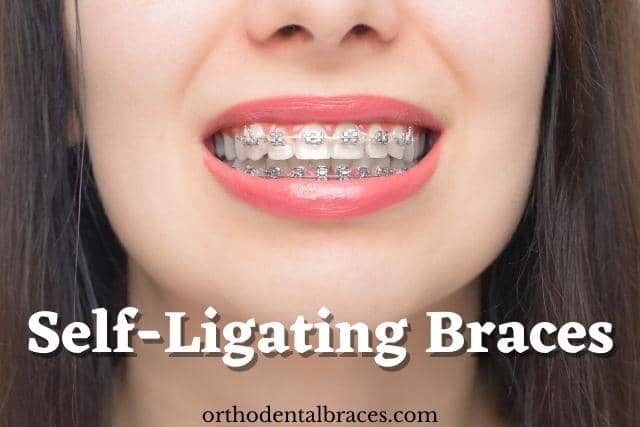Everything about Self-ligating braces

What are self-ligating braces?
Self-ligating braces are a type of orthodontic brace that uses a system built into the bracket itself to hold the archwire. This system eliminates the need for elastic bands or metal ties. Self-ligating braces are sometimes referred to as automatic, passive or micro retention.
At first glance, self-ligating braces look similar to traditional braces. However, they are specially designed to hold the archwire in place without the use of elastic bands or metal ties.
Self-ligating braces vs. traditional braces
One of the main differences between self-ligating braces and traditional braces is how they are manufactured. Traditional brackets have a rectangular wire opening, so two separate layers are needed to form the bracket. One layer creates the bottom half of the bracket, while another layer forms the top section.
Self-ligating brackets are made in one piece, so the wire opening is round. This makes manufacturing easier.
Another difference between self-ligating braces and traditional brackets involves how they secure the archwire in place:
- Traditional braces use a tiny elastic band or metal tie to attach them to the archwire
- Self-ligating braces use a special system built right into the bracket itself.
There are many different types of self-ligating brackets available, but they all work in the same way. Some use a sliding mechanism to hold the archwire in place. Others have a hinged gate that makes attachment and detachment easier. Still others have specialty mechanisms for specific cases.
Regardless of which type you choose, they are all designed to simplify your treatment by eliminating the need for ligatures.
How do self-ligating braces work?
Self-ligating braces reduce friction between the archwire and bracket, which can help keep appliances in place. This is especially important when you have bands that apply pressure to the teeth being straightened. When using self-ligating braces, you will need to use special ties to attach the archwire to the bracket. These are called ligatures.
Choosing brackets based on the size of teeth
Brackets come in many different sizes, so it’s important to make sure you choose one that fits you perfectly. If the bracket is too large, it won’t fit against your tooth properly. If the bracket is too small for your teeth, you may experience discomfort.
Self-ligating brackets are available in a range of tooth sizes, making it easy to find one that works best for you.
Pros of Self-ligating braces
- May reduce the number of office visits for adjustments, thanks to the limited need for ligatures
- Eliminate metal ties and elastic bands that can cause irritation to your mouth, gums or lips
- Can be used on any arch shape
Cons of Self-ligating braces
- More expensive than traditional braces
- May need additional appointments to receive new ligatures if they become loose or break
Do Self-ligating braces hurt?
Self-ligating braces do not hurt. They also have a limited need for attachments that can cause irritation to your mouth.
However, you may experience some discomfort if the brackets don’t fit properly against your teeth. If your brackets are too large, they will rub against your tooth and cause pain. If your brackets are too small for your teeth, you may experience discomfort.
Cost of Self-ligating braces
Self-ligating braces are more expensive than traditional braces, but it may be worth the investment if you want to reduce discomfort or save time.
When choosing which type of brace is right for your teeth, it’s important to consider your budget and talk with your orthodontist about how much self-ligating braces cost.
Since traditional braces are less expensive, they may be a better choice if you cannot afford self-ligating braces. However, if you want to save time or experience less discomfort during treatment, self-ligating braces can be well worth the monetary investment.
Precautions with Self-ligating braces
Self-ligating braces are safe to use, but you must take the following precautions:
- Always keep your brackets clean, since bacteria can build up on them over time.
- If you have any discomfort with your brackets or rubber bands, be sure to talk it over with your orthodontist right away.
- If your rubber bands are broken or loose, do not attempt to fix them yourself.
Although self-ligating braces are generally safe, they can become unsafe if you do not take the proper precautions during treatment.
How long do Self-ligating braces last?
Typically, self-ligating braces are designed to last for the same amount of time as traditional metal braces.
While your orthodontist will recommend a treatment plan that fits your needs, the average time it takes for self-ligating braces to correct teeth is about two years. Getting regular adjustments every four to six weeks can help you maintain your results.
As with traditional metal braces, self-ligating braces take time to straighten your teeth. However, the average treatment time for both is about two years. You can maintain your results by going in for regular checkups every four to six weeks.
Maintaining Your Self-ligating Braces
Self-ligating braces are similar to traditional metal braces in many ways, but they use rubber bands instead of metal ties
Generally, you should not replace your rubber bands more often than every three months. If you wear them longer or replace them too frequently, the brackets will wear down and may cause pain during treatment.
Conclusion:
While self-ligating braces come with a higher price tag than traditional metal braces, they may be worth the investment if you want to reduce discomfort or save time.
If you still have questions about whether your teeth will fit into a self-ligating bracket, talk to your orthodontist and make sure to ask them about cost as well.
References:
